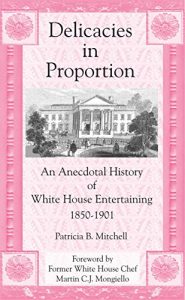An overview of food and entertaining in the White House, 1850–1901. 17 recipes; 144 research notes; 13,691 words. Authored by Patricia B. Mitchell. Edited by Sarah E. Mitchell. Foreword by former White House chef Martin C.J. Mongiello.
“[D]elicacies in proportion” (the title of this book) were the words used by Washington correspondent and writer Ben Perley Poore to complete a list of the foods served at a presidential inaugural ball supper in 1881. The book discusses White House food and entertaining under the twelve administrations between 1850 and 1901. — Other administrations are covered in companion White House books by Patricia B. Mitchell: "That Palace in Washington" (1800-1850) and "Plain Food and High Thinking" (1901-1953).
Smile-producing stories, presidential food preferences, and evocative descriptions make "Delicacies in Proportion" a pleasure to read. Quotations add to the charm of the book. For example, the remark, “Why, I never get tired of having a good time” shows the attitude that enabled Lucy Hayes to adapt well to the social obligations which she was expected to carry out.
The “humanness” of President Cleveland is revealed in a dialogue involving his instructions to exchange his fancy dinner for the servants' bill of fare. (He wasn't trying to be noble — he preferred what they were having.)
The copious endnotes in "Delicacies in Proportion" are useful to scholars and anyone interested in additional worthwhile reading and research.
Featured in the book are: Millard and Abigail Fillmore; Franklin and Jane Pierce; James Buchanan; Abraham and Mary Lincoln; Andrew and Eliza Johnson; Ulysses and Julia Grant; Rutherford and Lucy Hayes; James and Lucretia Garfield; Chester Arthur; Grover and Frances Cleveland; Benjamin and Caroline Harrison; and William and Ida McKinley.
This and other books by Patricia B. Mitchell were first written for museums and their patrons, and are now available as Kindle editions. Each of her books summarizes a food history topic, using quotations and anecdotes from early sources to both entertain and inform. She carefully lists her references to make it easy for others to launch their own research.
Since the 1980's Patricia Mitchell's work is a proven staple of American museum culture. Her readers love to share her ever-present sense of discovery. Her sales are approaching a million copies, and she is widely known by her web identity FoodHistory.com.
“[D]elicacies in proportion” (the title of this book) were the words used by Washington correspondent and writer Ben Perley Poore to complete a list of the foods served at a presidential inaugural ball supper in 1881. The book discusses White House food and entertaining under the twelve administrations between 1850 and 1901. — Other administrations are covered in companion White House books by Patricia B. Mitchell: "That Palace in Washington" (1800-1850) and "Plain Food and High Thinking" (1901-1953).
Smile-producing stories, presidential food preferences, and evocative descriptions make "Delicacies in Proportion" a pleasure to read. Quotations add to the charm of the book. For example, the remark, “Why, I never get tired of having a good time” shows the attitude that enabled Lucy Hayes to adapt well to the social obligations which she was expected to carry out.
The “humanness” of President Cleveland is revealed in a dialogue involving his instructions to exchange his fancy dinner for the servants' bill of fare. (He wasn't trying to be noble — he preferred what they were having.)
The copious endnotes in "Delicacies in Proportion" are useful to scholars and anyone interested in additional worthwhile reading and research.
Featured in the book are: Millard and Abigail Fillmore; Franklin and Jane Pierce; James Buchanan; Abraham and Mary Lincoln; Andrew and Eliza Johnson; Ulysses and Julia Grant; Rutherford and Lucy Hayes; James and Lucretia Garfield; Chester Arthur; Grover and Frances Cleveland; Benjamin and Caroline Harrison; and William and Ida McKinley.
This and other books by Patricia B. Mitchell were first written for museums and their patrons, and are now available as Kindle editions. Each of her books summarizes a food history topic, using quotations and anecdotes from early sources to both entertain and inform. She carefully lists her references to make it easy for others to launch their own research.
Since the 1980's Patricia Mitchell's work is a proven staple of American museum culture. Her readers love to share her ever-present sense of discovery. Her sales are approaching a million copies, and she is widely known by her web identity FoodHistory.com.






